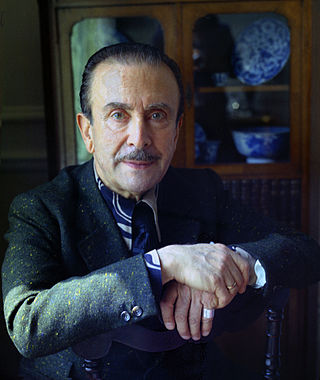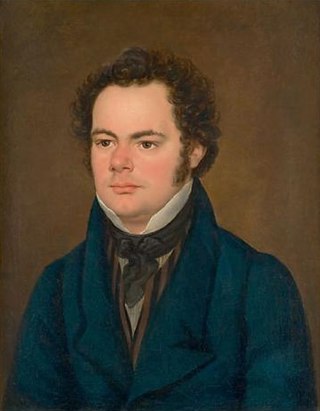
Alfred Brendel is an Austrian classical pianist, poet, author, composer, and lecturer who is noted for his performances of Mozart, Schubert and Beethoven.

Claudio Arrau León was a Chilean pianist known for his interpretations of a vast repertoire spanning the baroque to 20th-century composers, especially Bach, Mozart, Beethoven, Schubert, Chopin, Schumann, Liszt and Brahms. He is widely considered one of the greatest pianists of the twentieth century.

Wilhelm Walter Friedrich Kempff was a German pianist, teacher and composer. Although his repertoire included Bach, Mozart, Chopin, Schumann, Liszt and Brahms, Kempff was particularly well known for his interpretations of the music of Ludwig van Beethoven and Franz Schubert, recording the complete sonatas of both composers. He is considered to have been one of the chief exponents of the Germanic tradition during the 20th century and one of the greatest pianists of all time.
Variations on a Theme of Paganini, Op. 35, is a work for piano composed in 1863 by Johannes Brahms, based on the Caprice No. 24 in A minor by Niccolò Paganini.

Étude Op. 10, No. 12 in C minor, known as the "Revolutionary Étude" or the "Étude on the Bombardment of Warsaw", is a solo piano work by Frédéric Chopin written c. 1831, and the last in his first set, Etudes, Op. 10, dedicated "à son ami Franz Liszt". The autograph is located in the archive of Stiftelsen Musikkulturens Främjande in Stockholm.

The Royal Philharmonic Society (RPS) is a British music society, formed in 1813. Its original purpose was to promote performances of instrumental music in London. Many composers and performers have taken part in its concerts. It is now a membership society, and while it no longer has its own orchestra, it continues a wide-ranging programme of activities which focus on composers and young musicians and aim to engage audiences so that future generations will enjoy a rich and vibrant musical life. Since 1989, the RPS has promoted the annual Royal Philharmonic Society Music Awards for live music-making in the United Kingdom.
The Ballades, Op. 10, are lyrical piano pieces written by Johannes Brahms during his youth. They were dated 1854 and were dedicated to his friend Julius Otto Grimm. Their composition coincided with the beginning of the composer's lifelong affection for the pianist and composer Clara Schumann, who was helping Brahms launch his career. Frédéric Chopin had written the last of his famous ballades only 12 years earlier, but Brahms approached the genre differently from Chopin, choosing to take its origin in narrative poetry more literally.

The Ballade No. 1 in G minor, Op. 23 is a ballade for solo piano by Frédéric Chopin. Completed in 1835, it is one of Chopin's greatest and most popular works. A typical performance lasts nine to ten minutes.

The English Suites, BWV 806–811, are a set of six suites written by the German composer Johann Sebastian Bach for harpsichord and generally thought to be the earliest of his 19 suites for keyboard, the others being the six French Suites, the six Partitas and the Overture in the French style. They probably date from around 1713 or 1714.
Jacques Leiser is an international artists manager and photographer who has represented and collaborated with many of the world's greatest concert pianists, composers, violinists and singers.

Étude Op. 10, No. 1 in C major is a study for solo piano composed by Frédéric Chopin in 1829. It was first published in 1833 in France, Germany, and England as the first piece of his Études Op. 10. This study in reach and arpeggios focuses on stretching the fingers of the right hand. The American music critic James Huneker (1857–1921) compared the "hypnotic charm" that these "dizzy acclivities and descents exercise for eye as well as ear" to the frightening staircases in Giovanni Battista Piranesi's prints of the Carceri d'invenzione. Virtuoso pianist Vladimir Horowitz, who refused to perform this étude in public, said, "For me, the most difficult one of all is the C Major, the first one, Op. 10, No. 1."

Étude Op. 10, No. 2, in A minor, is a technical study composed by Frédéric Chopin for the piano. It was preceded by a relative major key. Composed in November 1829, it was first published in 1833 in France, Germany, and England. This étude is an exercise in developing the independence of the weaker fingers of the right hand by playing rapid chromatic scale figures with the third, fourth, and fifth fingers of the right hand. Meanwhile, the first two fingers of the right and the left hand play an accompaniment of short intervals and single notes. Chopin indicated the fingering himself note by note for almost 800 notes.
Concert Artist/Fidelio Recordings was a British classical music record label, situated in Royston, Hertfordshire, England, and owned and operated by William Barrington-Coupe. It is best known for selling unauthorized copies of commercial recordings by other artists as the work of pianists Sergio Fiorentino and Barrington-Coupe's wife, Joyce Hatto. Barrington-Coupe's long history in the music world includes time with Saga Films and Records and pop record producer Joe Meek. The company issued recordings from 1955 until 2007.
Étude Op. 25, No. 2, in F minor, is an étude composed by Frédéric Chopin. It was marked 'Presto'. It was preceded by a relative major key. It is based on a polyrhythm, with pairs of eighth-note (quaver) triplets in the right hand against quarter-note (crotchet) triplets in the left. The étude is sometimes known as "The Bees".

Six moments musicaux, D. 780 is a collection of six short pieces for solo piano composed by Franz Schubert. Along with the Impromptus, they are among the most frequently played of all Schubert's piano music, and have been recorded many times. No. 3 in F minor has been arranged by Leopold Godowsky and others.
The late piano sonatas of Ludwig van Beethoven usually refer to the last five piano sonatas the composer composed during his late period.

The Fantasie in C, Op. 17, was written by Robert Schumann in 1836. It was revised prior to publication in 1839, when it was dedicated to Franz Liszt. It is generally described as one of Schumann's greatest works for solo piano, and is one of the central works of the early Romantic period. It is often called by the Italian version, fantasia; the word "Fantasie" is the German spelling.
Launched by Gramophone magazine in late 2011, the Gramophone Hall of Fame is an annual listing of the people who have contributed to the classical record industry. Fifty individuals and ensembles entered the Hall of Fame in its first year. A special edition of the magazine celebrates this new initiative, and the list was first published online on 6 April 2012.











